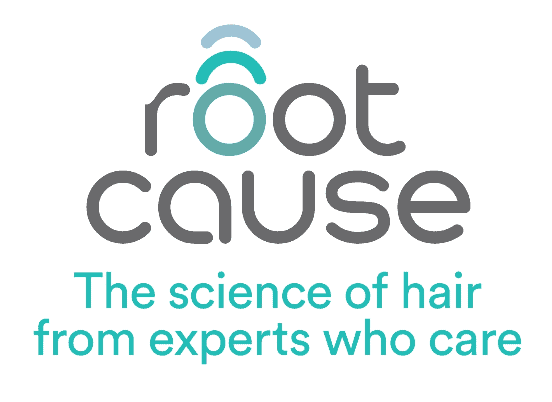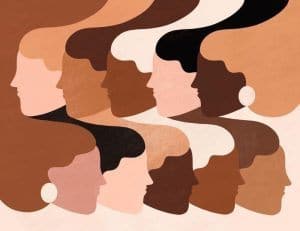Racial Bias in Healthcare and Trichology
01.25.23

Knowing how to feel confident in recognising the clinical presentation of various scalp and hair conditions on clients of all racial backgrounds ensures that a healthcare provider or trichologist delivers a quality service to ALL who need help.
At Root Cause Clinical, we provide Continuing Professional Development (CPD) training to all our associate trichologists to ensure we are aware of racial bias.
Why is it essential for trichologists to recognise scalp and hair conditions on all skin tones and hair types?
It is crucial that trichologists and dermatologists are able to offer a good quality service to clients of any gender, racial background, skin colour, or hair type, as everybody deserves access to a healthy scalp and hair.
Unfortunately, most dermatology and trichology training programs are dispensed mainly with references to white or light-pigmented skin tones and straight-to-wavy hair types. When examining a client, an accurate diagnosis largely depends on the practitioner recognising clinical signs of scalp and hair conditions. This bears influence on the proposed treatment plan as well as the prognosis.
Lack of representation is part of the problem.
Representation is vital so that everybody can have access to trichology services, but having been trained only to recognise conditions on white skin tones puts non-white, afro-textured-haired clients at a disadvantage. Some conditions, such as central centrifugal cicatricial alopecia (CCCA) and acne keloidalis nuchae (AKN), are more prevalent in darker skin and may present differently than they do on whiter skin.
“If you’re only trained to look at something in one colour, you won’t recognise it in another colour.”1 says Dr. Jenna Lester, director of the skin of colour program at the University of California, San Francisco, in a New York Times article published in 2020.
One example is erythema (redness), used as a hallmark sign in identifying inflammation on the scalp for conditions such as psoriasis, eczema, and some types of scarring alopecia (hair loss that can become permanent if left untreated) such as lichen planopilaris. This “redness” can look anything but red on darker skin tones, as the colour observed also depends on the background skin tone, often coming off as shades of purple, brown, and blue or grey hues.
Despite the increasing diversity of demographics in Europe and the U.K., it is still quite common for dermatologists and trichologists to have almost no experience in recognising patterns and signs of diseases on darker skin. 2
Dermatologists in Ireland completed an online survey in 2022 which resulted in the following observation: “Irish dermatologists have low confidence with skin pathology in skin of colour (SOC), and specific training could reduce this disparity” 3. Although this study was based in Ireland, it reflects most western societies, including Europe, the U.S. and the U.K.
Racial bias in healthcare is real
Racial bias in medicine has a longstanding history.
Racial bias in medicine is a real thing. Many BIPOC (Black, Indigenous, and People of Colour) face challenges that Caucasians do not when it comes to accessing quality healthcare. Many black women, for example, are often denied pain medications due to false beliefs in biological differences between races4.
Additionally, the depiction of skin diseases in medical textbooks shows a disproportionately high percentage of sexually transmitted diseases images on black skin reminiscent of the Tuskegee Syphilis Study by the U.S Public Health Service between 1932 and 1972, whilst there is often a minimal depiction of common skin conditions such as acne or dermatitis on darker skin5. There is an almost insidiously infused negative association at the very root in healthcare practitioners when dealing with patients of colour. This inevitably results in many BIPOC being misdiagnosed, sometimes with grave consequences, especially when a physician or trichologist does not recognise skin cancer signs and the disease is left untreated.
“The dermatology and broader healthcare community needs to acknowledge and educate ourselves on the health impacts of racism” 6. Shanti Narla
How can we resolve this issue, especially in trichology?
As telehealth services gain traction, it is even more critical now that trichologists and other healthcare practitioners have adequate competency in recognising and treating scalp and hair conditions in all skin and hair types.

Dr Sharon Belmo, Consultant Dermatologist
Dr Sharon Belmo (Consultant Dermatologist and Clinical Lead) and CEBD (Centre of Evidence Based Dermatology, University of Nottingham) have compiled a Skin of Colour Resource to aid with recognising the clinical presentation of dermatological conditions on non-white skin. By extrapolation, trichologists will benefit from this resource too. 7

Malone Mukwende
In August 2020, medical student Malone Mukwende published “Mind the Gap”, a handbook of images and clinical signs and symptoms as they present in Black and Brown skin. He noticed that there were almost no examples of certain disease representations on darker skin tones, and he decided to do something about it. The handbook is now freely available as a downloadable PDF online8.
Why is this important for Root Cause Clinical?
Our Board Advisor, Jacky van Driel-Nguene is very passionate about ensuring that we can educate both our trichologists and the broader community on racial bias.

Jacky van Driel-Nguene
“There are many other doctors and healthcare practitioners worldwide working towards the same goal of equality in the medical field, but it sometimes feels like one is screaming in an echo chamber. At Root Cause Clinical, we aim to empower our trichologists with the knowledge to increase their confidence in diagnosing scalp and hair conditions on all skin tones and hair types”.
If you have a hair or scalp health condition that worries you, especially if you are a person of colour, why not book an initial online trichology consultation and talk to one of our qualified trichologist practitioners?
References
- Dermatology Has a Problem With Skin Color. The New York Times. August 2020. https://www.nytimes.com/2020/08/30/health/skin-diseases-black-hispanic.html
- Office for National Statistics. Ethnicity and National Identity in England and Wales 2011. 11 Dec 2012. [Accessed 1 March 2021]
- O’Connor, C et al. “Confidence of Irish dermatologists in caring for patients with skin of colour.” Clinical and experimental dermatology vol. 47,1 (2022): 169-171. doi:10.1111/ced.14897
- Hoffman KM, Trawalter S, Axt JR, Oliver MN. Racial bias in pain assessment and treatment recommendations, and false beliefs about biological differences between blacks and whites. Proc Natl Acad Sci U S A. 2016 Apr 19;113(16):4296-301. doi: 10.1073/pnas.1516047113. Epub 2016 Apr 4. PMID: 27044069; PMCID: PMC4843483.
- The U.S. Public Health Service Syphilis Study at Tuskegee. CDC (Centers for Disease Control and Prevention. https://www.cdc.gov/tuskegee/index.html
- Narla, Shanthi et al. “Racial disparities in dermatology.” Archives of dermatological research, 1–9. 12 Dec. 2022, doi:10.1007/s00403-022-02507-z
- Centre of Evidence Based Dermatology. Skin of Colour Resource. University of Nottingham, UK, China, Malaysia.
- Malone Mukwende, Mind The Gap, free downloadable PDF handbook. https://www.blackandbrownskin.co.uk/mindthegap

